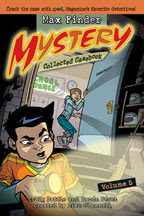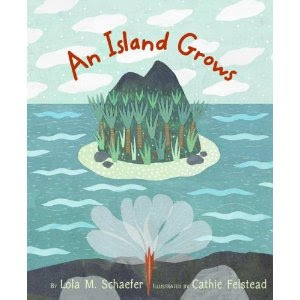 Max Finder and his friends are middle school (junior high) detectives who were first featured in Owl Magazine. Created by Liam O'Donnell, and written and illustrated by Craig Battle and Ramon Perez, this volume opens with a "Central Meadows Junior High Yearbook, complete with "photos" of the students, listing their clubs/sports, a "most likely to" statement and favorite movies/quotes. This clever introduction to the characters not only serves to introduce new readers to the cast, but also provides a fun refresher to long-time fans. Each case includes all of the clues needed to solve the mystery--some in words and some in pictures. Solutions are provided at the end of each case, including a listing of the various clues and the ultimate conclusion. The mysteries are fun, the illustrations vivid, and the characters real--most students will be able to relate to (and probably recognize) some of the same people in their own schools.
Max Finder and his friends are middle school (junior high) detectives who were first featured in Owl Magazine. Created by Liam O'Donnell, and written and illustrated by Craig Battle and Ramon Perez, this volume opens with a "Central Meadows Junior High Yearbook, complete with "photos" of the students, listing their clubs/sports, a "most likely to" statement and favorite movies/quotes. This clever introduction to the characters not only serves to introduce new readers to the cast, but also provides a fun refresher to long-time fans. Each case includes all of the clues needed to solve the mystery--some in words and some in pictures. Solutions are provided at the end of each case, including a listing of the various clues and the ultimate conclusion. The mysteries are fun, the illustrations vivid, and the characters real--most students will be able to relate to (and probably recognize) some of the same people in their own schools.As a teacher, I am always excited to find new ways to introduce and expand on concepts. The Max Finder Mysteries are divided into bite-sized chunks perfect for before lunch, before dismissal, or those time periods that are just too short for a full-fledged lesson. Any one of these mysteries offers a great lead-in to a brainstorming session on "character counts" topics such as honesty, caring and respect; but the creators has also included some ready-made lessons. I really like is the "How to Be a Detective" section in the back of this volume. With an increased emphasis on research and writing skills in our school district, this section offers a fun approach to research, couched in terms of mystery solving--perfect considering how many of my students like to watch crime drama. Sections are titled "Conducting Research," "Making Observations," and "Completing Cases," with insets defining "Detective Lingo" such as alibi, red herring and inference. Each section is "co-authored" by Alison and Max, giving an equal-opportunity "feel" to the article and providing two distinctly different perspectives on each. I particularly like the definition given for "inference" and think this might just offer a new path to understanding of a difficult concept. As a further bonus, a "Sit Down With the Creators" is included in an interview format, where the creators/writers/artists answer questions such as "What inspires you to come up with a story?" This offers a great opportunity for the reader to hear some different answers to questions they themselves might ask the authors/illustrators. For educators, there is also a brief section on ways to use Max Finder in the classroom, including Readers' Theater, Genre Study and Character Study along with other classroom connections.
Overall, I suspect that once I use this volume in class, I will have several students asking for the other volumes and a waiting list to read them. For a first-hand look at Max Finder online, visit http://owlkids.com/owl/maxfinder.html.





